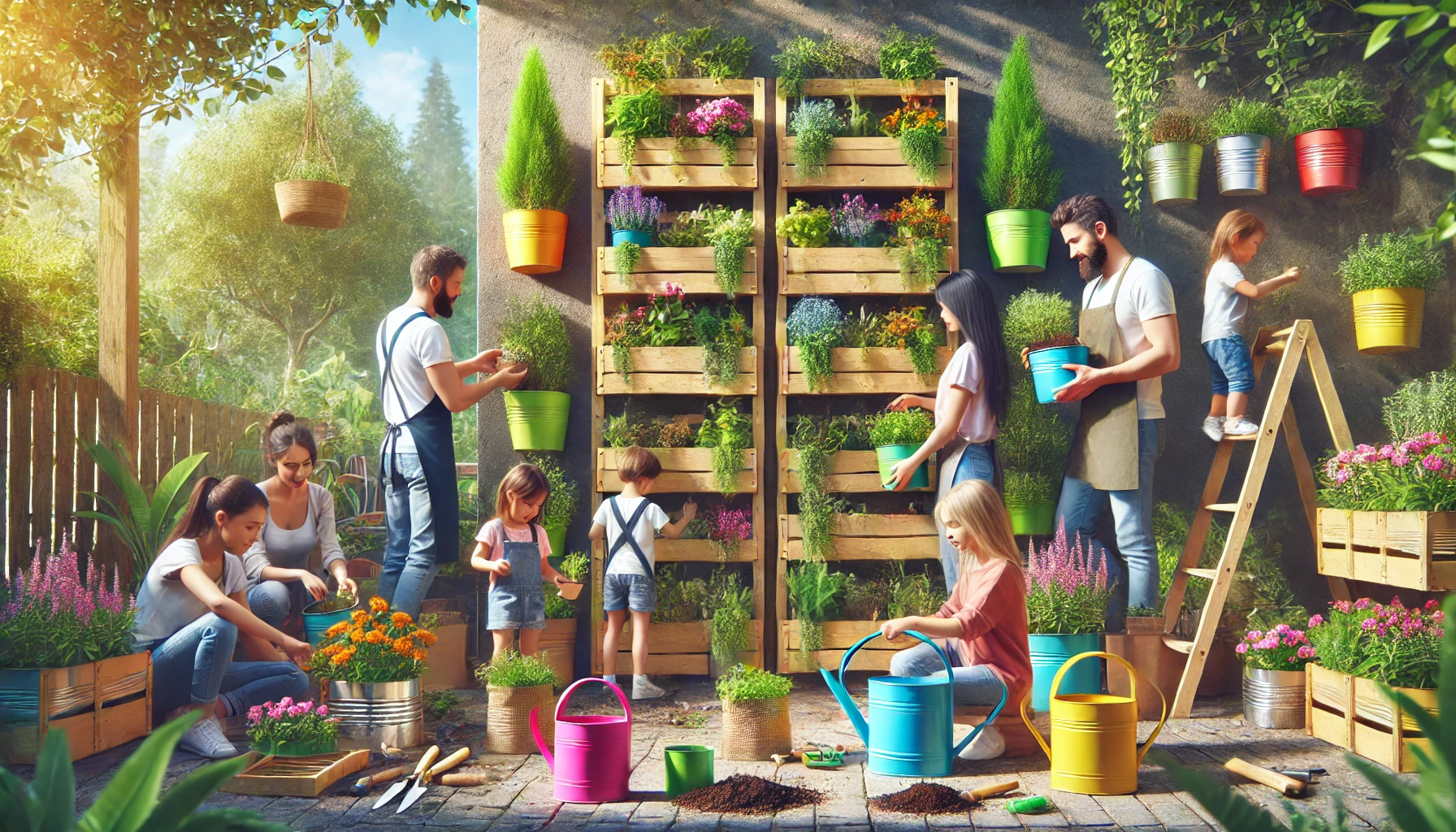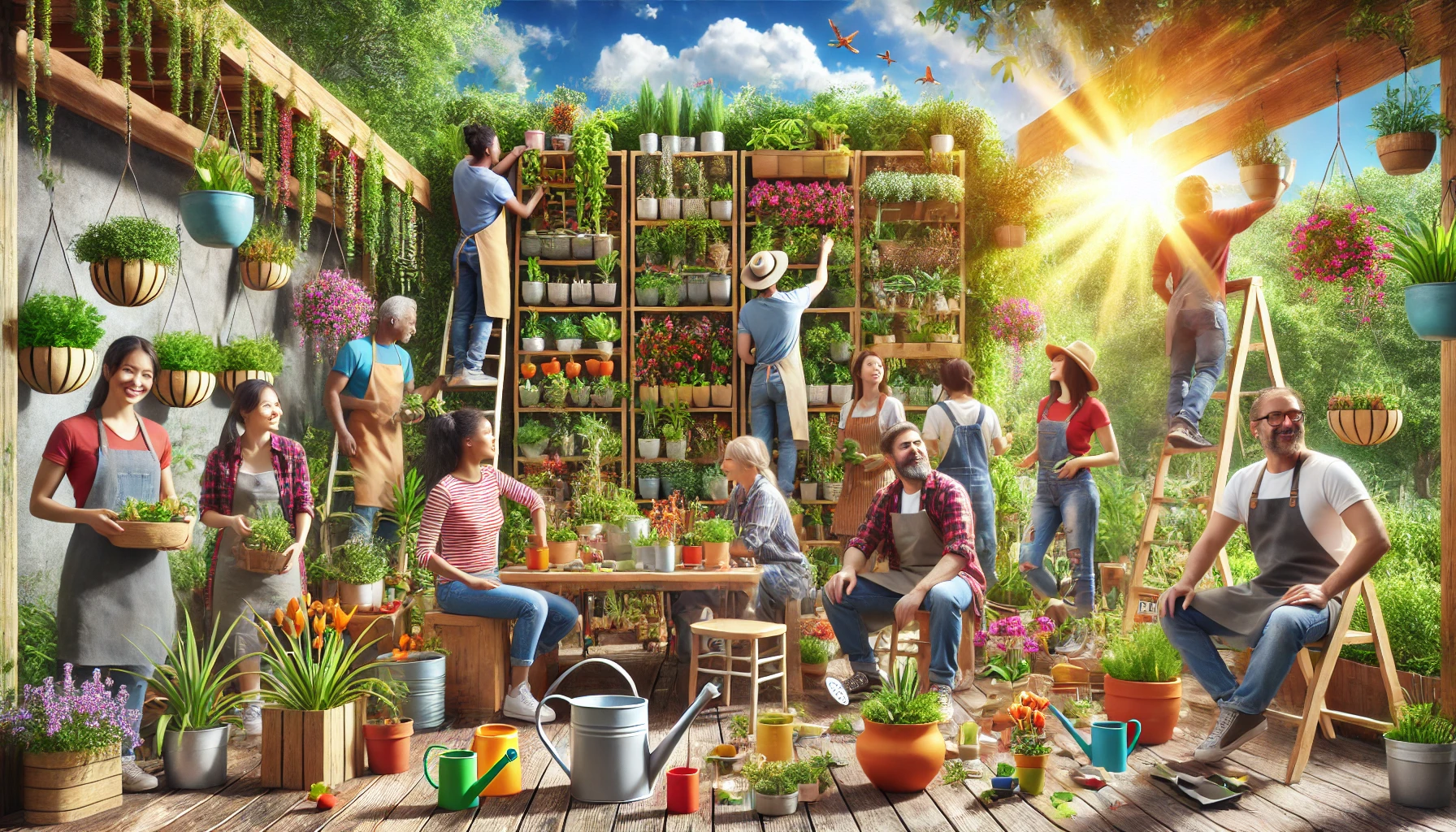Vertical gardening has become a buzzword in the gardening community, and for good reason. Defined as the practice of growing plants upward rather than outward, vertical gardening makes use of walls, trellises, and other upright structures to cultivate a thriving garden in minimal space.
In today’s world, where urban living often comes with space constraints, vertical gardening is revolutionizing how we think about greenery.
Why is vertical gardening gaining so much popularity? For one, it allows people with limited outdoor space, such as apartment dwellers, to enjoy the benefits of gardening.
Beyond space efficiency, vertical gardens add aesthetic value, improve air quality, and can even boost mental well-being. Additionally, they offer practical benefits like easier harvesting, reduced pest issues, and improved accessibility.
This article focuses on the exciting realm of DIY vertical gardening systems, empowering you to create your own green oasis without breaking the bank.
Whether you’re an experienced gardener or a complete beginner, this guide will walk you through the essentials of getting started, step-by-step instructions, and maintenance tips to ensure success.
Getting Started: What You Need for a DIY Vertical Garden
Before diving into building your vertical garden, it’s essential to gather the right tools, understand the types of structures available, and explore cost-effective ways to source materials.
Essential Tools and Materials
To create a DIY vertical garden, you’ll need:
- Basic Tools: Hammer, nails, screws, drill, measuring tape, and a saw.
- Structural Materials: Wooden pallets, PVC pipes, mesh panels, or old ladders.
- Containers: Pots, buckets, or recycled bottles.
- Gardening Supplies: Quality soil, fertilizer, seeds, or seedlings.
- Irrigation Setup: A watering can, drip irrigation system, or a hose.
Types of Vertical Gardening Structures
There’s no one-size-fits-all approach to vertical gardening. Here are some popular structures to consider:
- Wall-Mounted Gardens: Utilize shelves, pockets, or pots attached to a wall.
- Trellises and Arbors: Ideal for climbing plants like cucumbers or beans.
- Hydroponic Towers: Perfect for growing herbs and leafy greens without soil.
- Hanging Gardens: Use hooks and ropes to suspend pots or planters.
Budget-Friendly Tips
Creating a vertical garden doesn’t have to be expensive. Here are some tips:
- Recycle Materials: Use old wooden crates, tin cans, or plastic bottles as planters.
- Shop Secondhand: Look for discounted tools and materials at thrift stores.
- DIY Compost: Save on fertilizer costs by making your own compost at home.
- Ask Around: Neighbors or local businesses may have free or low-cost materials to spare.
Step-by-Step Guide: How to Create a DIY Vertical Garden
Ready to build your vertical garden? Follow these steps to create a functional and beautiful system:
Step 1: Plan Your Design
- Assess Your Space: Choose a location that receives adequate sunlight and complements your home’s aesthetics.
- Sketch Your Layout: Decide on the structure, plant arrangement, and irrigation system.
Step 2: Build the Structure
- Wall-Mounted System: Secure wooden pallets or mesh panels to a sturdy wall.
- Free-Standing Frame: Construct a frame using PVC pipes or reclaimed wood for flexibility.
- Hanging Garden: Drill holes in recycled bottles or containers, string them with rope, and hang them at different heights.
Step 3: Prepare the Containers
- Ensure containers have proper drainage holes to prevent waterlogging.
- Fill each container with nutrient-rich soil and compost.
Step 4: Plant Your Garden
- Arrange Plants Strategically: Place taller plants at the top and smaller ones at the bottom to optimize sunlight exposure.
- Space Appropriately: Allow room for plants to grow and spread.
Step 5: Install an Irrigation System
- A simple drip irrigation setup can save time and water.
- For small gardens, watering cans or hoses may suffice.
Step 6: Add Finishing Touches
- Decorate with colorful pots or LED lights for nighttime ambiance.
- Label your plants to keep track of growth and care requirements.
Top Techniques for Successful Vertical Gardening
To ensure your vertical garden thrives, it’s crucial to adopt effective gardening techniques.
Vertical Gardening Techniques
- Hydroponics: Grow plants in nutrient-rich water instead of soil. This technique is particularly advantageous for small spaces and allows for faster growth rates and higher yields.
- Trellising: Use trellises for climbing plants to maximize vertical space. Trellising is especially useful for vegetables like tomatoes, beans, and cucumbers, as it keeps them off the ground and reduces the risk of pests and diseases.
- Modular Systems: Stack planters or use grid systems for easy reorganization. Modular systems are excellent for beginners as they allow flexibility and scalability.
Best Practices
- Regular Pruning: Prevent overcrowding and encourage healthy growth. Pruning also improves airflow, reducing the chances of fungal diseases.
- Soil Health: Use high-quality soil and refresh it seasonally. Adding organic matter such as compost or worm castings enhances nutrient content.
- Pest Control: Inspect plants regularly and use natural remedies like neem oil. Companion planting can also help deter pests—for instance, planting marigolds alongside vegetables.
Space Maximization Tips
- Interplanting: Combine fast-growing and slow-growing plants to make the most of your vertical space. For example, plant lettuce alongside taller crops like tomatoes.
- Vertical Shelves: Use multi-tiered shelves for small pots to create additional growing space.
- Overhead Gardening: Suspend lightweight plants like herbs from ceilings to utilize overhead space efficiently.
Selecting Plants: What Grows Best in a Vertical Garden?
Choosing the right plants is key to a flourishing vertical garden. When selecting plants, consider factors like weight, root depth, and sunlight requirements.
Vegetables and Herbs
- Leafy Greens: Lettuce, spinach, and kale thrive in vertical gardens and require minimal maintenance.
- Climbing Vegetables: Tomatoes, cucumbers, and pole beans are ideal for vertical setups and can be trained to grow upward using trellises.
- Herbs: Basil, parsley, mint, and thyme are excellent choices for vertical gardens. They are lightweight, aromatic, and easy to harvest.
Flowers
- Climbers: Morning glories, clematis, and jasmine add a touch of beauty to vertical gardens. Their climbing nature makes them perfect for trellises and arbors.
- Compact Varieties: Petunias, marigolds, and pansies work well in small containers and add vibrant colors to your garden.
Key Considerations
- Plant Weight: Choose lightweight plants for wall-mounted systems to avoid structural strain.
- Root Depth: Opt for shallow-rooted plants in small containers, such as lettuce and herbs.
- Seasonality: Rotate crops seasonally to ensure continuous harvests and maintain soil health.
Advanced Plant Pairing
For more advanced gardeners, consider plant pairing to maximize efficiency. For instance, pair marigolds with tomatoes to deter pests or grow radishes alongside carrots to loosen soil and promote healthy root development.
Potential Drawbacks of Vertical Gardens
While vertical gardening has many advantages, it’s important to be aware of potential challenges and how to address them effectively.
Common Issues
- Watering Difficulties: Uneven moisture distribution can be problematic in vertical systems, especially for wall-mounted gardens.
- Structural Instability: Poorly constructed systems may collapse under the weight of plants and soil.
- Limited Plant Choices: Some plants may outgrow vertical systems or require more space than what is available.
- Maintenance Challenges: Vertical gardens may require more frequent monitoring and care compared to traditional gardens.
Solutions
- Use drip irrigation or self-watering containers to ensure consistent moisture levels.
- Reinforce structures with durable materials such as treated wood or metal frames.
- Choose plant varieties suited for vertical setups and regularly trim or prune to manage growth.
- Develop a maintenance schedule to monitor plant health, watering needs, and structural stability.

Troubleshooting Tips
- If plants appear wilted, check for drainage issues and adjust watering frequency.
- Address pest infestations promptly using organic solutions or beneficial insects like ladybugs.
- Reassess plant arrangements if overcrowding becomes an issue, moving larger plants to separate containers.
Care and Maintenance of Vertical Gardens
A well-maintained vertical garden will reward you with lush greenery and bountiful harvests year-round.
Watering and Fertilization
- Watering: Check soil moisture levels daily, especially during hot weather. Water plants early in the morning or late in the afternoon to reduce evaporation.
- Fertilization: Apply organic fertilizer every 4-6 weeks to ensure plants receive adequate nutrients. Liquid fertilizers can be particularly effective for vertical systems.
Pest Control
- Inspect plants regularly for signs of pests such as aphids, spider mites, and whiteflies.
- Use natural repellents like garlic spray or companion planting to deter pests. For example, plant chives near roses to repel aphids.
- Introduce beneficial insects like ladybugs and lacewings to naturally control pest populations.
Seasonal Adjustments
- Protect plants from frost during winter by covering them with burlap or moving containers indoors.
- During summer, ensure adequate ventilation and provide shade for plants that are sensitive to intense sunlight.
- Rotate crops and refresh soil seasonally to maintain soil fertility and prevent nutrient depletion.
Sustainability and Eco-Friendliness of Vertical Gardening
Vertical gardening offers numerous environmental benefits and opportunities for sustainable practices, making it an ideal choice for eco-conscious gardeners.
Environmental Benefits
- Local Food Production: Growing food locally reduces the carbon footprint associated with transportation.
- Air Quality Improvement: Vertical gardens contribute to cleaner air by absorbing carbon dioxide and releasing oxygen.
- Water Conservation: Drip irrigation systems in vertical gardens use significantly less water compared to traditional gardens.
Sustainable Practices
- Recycled Materials: Incorporate recycled wood, plastic bottles, and tin cans into your garden design.
- DIY Compost: Reduce food waste by creating nutrient-rich compost for your garden.
- Organic Gardening: Avoid chemical pesticides and fertilizers to promote healthier plants and ecosystems.
Real-Life Examples
- A community rooftop garden in New York City uses recycled pallets and rainwater collection systems to grow vegetables and herbs.
- A small apartment balcony in Tokyo is transformed into a lush garden with hanging planters made from old soda bottles.
- An eco-conscious family in London grows a variety of herbs and flowers using a DIY hydroponic system built from PVC pipes.
Conclusion: The Future of DIY Vertical Gardening Systems
Vertical gardening is more than just a trend; it’s a sustainable, practical, and rewarding way to bring greenery into your life. By engaging in DIY projects, you not only save money but also enjoy the satisfaction of creating something unique and functional.
As technology and innovation continue to evolve, the future of vertical gardening looks promising. From automated irrigation systems to eco-friendly materials, the possibilities are endless.
So, roll up your sleeves, gather your tools, and start building your own DIY vertical garden today. With creativity and care, you’ll soon have a thriving garden that brings beauty, freshness, and joy to your space.


Since I never seen these vertical gardens in the real world, except in this article, I thought they were just artificial plants. However, after reading your article, it seems they are real plants planted at home in these containers as you have in the pictures in this article. I have no experience with these gardens at all, but your article makes things easier for me.
John
Hi John,
Thank you so much for taking the time to read the article and for sharing your thoughts! I completely understand how vertical gardens can seem like artificial plants at first glance—it’s not something we come across every day in the real world. But yes, they are absolutely real plants, and the containers make it super easy to grow them at home, even if you have limited space.
I’m so glad to hear that the article made things easier for you! If you’re ever curious about starting your own vertical garden or have any questions, feel free to reach out. It’s a fun and rewarding way to bring some greenery into your space!
Wishing you all the best,
Herman